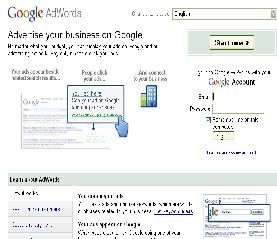Google’s Revenue Model
The main source of Google yearly income is derived from advertising revenue model. For the 2006 fiscal year, the company reported US$10.492 billion in total advertising revenues and only US$112 million in licensing and other revenues. The Google advertising programs include Google AdWords and Google AdSense. Google AdWords offers pay-per-click (PPC) advertising, and site-targeted advertising for both text and banner ads. The program includes local, national, and international distribution. It is designed to allow the advertisers to present advertisement to people are looking for information related to what the advertiser has to offer. Google AdWords is Google 's flagship advertising product and main source of revenue ($21 billion in 2008).
Google AdWords offers pay-per-click (PPC) advertising, and site-targeted advertising for both text and banner ads. The program includes local, national, and international distribution. It is designed to allow the advertisers to present advertisement to people are looking for information related to what the advertiser has to offer. Google AdWords is Google 's flagship advertising product and main source of revenue ($21 billion in 2008).
Google AdSense is an advertisement application. Website owners can enroll in this program to enable text, image, and more recently, video advertisements on their websites. These advertisements are administered by Google. It generates revenue on either a per-click or per-impression basis.
Related Link:
1. Google on Wikipedia
2. Google Adwords
Amazon’s Revenue Model
Besides Ebay, the best well-known online shopping on the Web is Amazon. It is  the web page of each product. Moreover, users are required to rate the product on a rating scale from one to five stars and comment on reviews.
the web page of each product. Moreover, users are required to rate the product on a rating scale from one to five stars and comment on reviews.
Amazon Marketplace is Amazon.com's fixed-price online marketplace that allows sellers to offer their goods alongside Amazon's offerings. Buyers can buy new and used items sold directly by a third party through Amazon.com using Amazon Marketplace. This sales strategy and program has been very profitable for Amazon.com. Amazon charges a commission rate based on the sale price, a transaction fee, and a variable closing fee. In other words, Amazon’s revenue is derived from sales revenue model and transaction fee revenue model.
Moreover, aStore is an Amazon.com affiliate product which website owners can use to create an online store on their site. The aStore interface is intended to be accessible to those without programming  skills, using configuration pages to customise the content and design. The store does not allow website owners to sell their own products directly. Website owners pick products from Amazon's store and earn referral fees on the products purchased by their readers. The fee structure is currently (August 2007) the same as for other affiliate links and ranges from 4% to 10% of the product price. Thus, we can say that Amazon’s revenue is generated about 40% of its sales from Affiliate revenue model.
skills, using configuration pages to customise the content and design. The store does not allow website owners to sell their own products directly. Website owners pick products from Amazon's store and earn referral fees on the products purchased by their readers. The fee structure is currently (August 2007) the same as for other affiliate links and ranges from 4% to 10% of the product price. Thus, we can say that Amazon’s revenue is generated about 40% of its sales from Affiliate revenue model.
1. Amazon on Wikipedia
Ebay’s Revenue Model
Ebay is an online auction and shopping website in which people and businesses buy and sell a broad variety goods and services worldwide. Millions of collectibles, decor, appliances, computers, furnishings, equipment, vehicles, and other miscellaneous items are listed, bought, and sold daily in the Ebay website.
Ebay generates revenue from insertion fees, final value fees and several optional adornment fees, all based on various factors and scales. Insertion fees are fees to list a product on Ebay. Final value fees are fees when the product sells. 
Besides that, Ebay generates revenue by transaction fees from owning the PayPal payment system which has fees of its own.
Furthermore, some of Ebay's revenue is also generated from advertising fee as well as sales. Ebay allows website owners to advertise their products.
Related Link:
1. Ebay on Wikipedia

0 comments:
Post a Comment